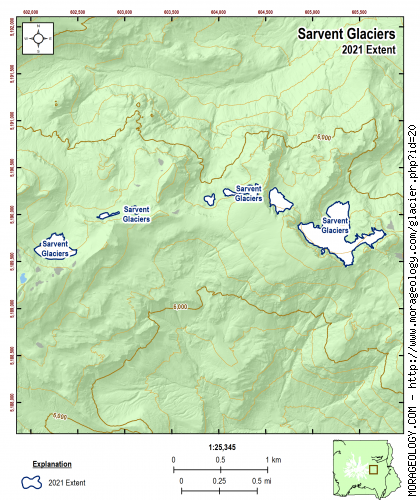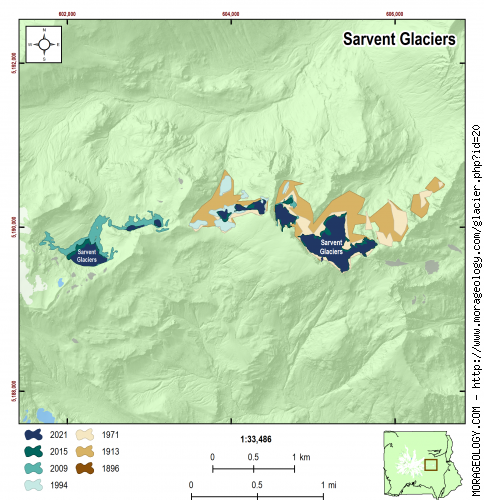NOTE: The data shown here is based on the 2021 glacier update at Mount Rainier, and should be considered the most up-to-date data on glaciers at the park (2023-04-06).
Sarvent Glaciers
The most easterly of the glaciers on the east slope east of the Meany Crest were named for Henry M. Sarvant, a surveyor and engineer, who made the first detailed map of the mountain. In 1895 Sarvent made what was called '....a comprehensive survey of the east side....' of the Mountain. At the time Sarvent was a Tacoma resident who was employed by Frederick G. Plummer, a civil Engineer who at one time was Pierce County auditor. (Reese, 2009)
Switch Glacier:

|
STATISTICS AS OF 2021 (Beason et al., 2023):
Aerial Extent:
0.147 ± 0.010 square miles
(0.380 ± 0.025 km2)
(Rank: 24 of 29)
Debris Cover - Based on data from 2015 (Beason, 2017):
--No appreciable debris cover in 2015--
Estimated Glacier Volume: (See notes below)
0.0016 ± 0.0006 cubic miles
(0.0066 ± 0.0023 km3)
Highest Elevation (Head):
7,304 feet
(2,226 m)
Lowest Elevation (Terminus):
6,033 feet
(1,839 m)
Elevation Range:
1,271 feet
(387 m)
Length:
0.36 miles
(0.58 km)
Average Slope:
32.11°
Average Flow Direction (direction the glacier flows towards):
North northeast (30°)
Glacier Type:
C - Cirque Glacier, or Glacier Head Starts Below Summit |

|
CHANGE IN EXTENT, 1896-2021 (Beason et al., 2023):
| Units |
1896 |
1913 |
1971 |
1994 |
2009 |
2015 |
2021 |
| Area, mi2 |
-- |
0.443 |
0.265 |
0.056 |
0.268 |
0.176 |
0.147 |
| Area, km2 |
-- |
1.148 |
0.686 |
0.146 |
0.695 |
0.455 |
0.380 |
Area Change Between Periods
|
1913 |
1971 |
1994 |
2009 |
2015 |
2021 |
| 1896 | -- | -- | -- | -- | -- | -- |
|---|
| 1913 | -- | -0.178 mi2
(-0.461 km2) | -0.387 mi2
(-1.002 km2) | -0.175 mi2
(-0.453 km2) | -0.268 mi2
(-0.693 km2) | -0.296 mi2
(-0.767 km2) |
|---|
| 1971 | | -- | -0.209 mi2
(-0.541 km2) | 0.003 mi2
(0.009 km2) | -0.089 mi2
(-0.232 km2) | -0.118 mi2
(-0.306 km2) |
|---|
| 1994 | | | -- | 0.212 mi2
(0.549 km2) | 0.119 mi2
(0.309 km2) | 0.091 mi2
(0.235 km2) |
|---|
| 2009 | | | | -- | -0.093 mi2
(-0.240 km2) | -0.121 mi2
(-0.314 km2) |
|---|
| 2015 | | | | | -- | -0.029 mi2
(-0.074 km2) |
|---|
Percent Change Between Periods
|
1913 |
1971 |
1994 |
2009 |
2015 |
2021 |
| 1896 | -- | -- | -- | -- | -- | -- |
|---|
| 1913 | -- | -40.20% | -87.31% | -39.44% | -60.38% | -66.85% |
|---|
| 1971 | | -- | -78.77% | 1.27% | -33.74% | -44.56% |
|---|
| 1994 | | | -- | 377.01% | 212.11% | 161.15% |
|---|
| 2009 | | | | -- | -34.57% | -45.25% |
|---|
| 2015 | | | | | -- | -16.33% |
|---|
|
|
ESTIMATED CHANGE IN VOLUME, 1896-2021 (Beason et al., 2023):
PLEASE see important notes about this, below...
Glacier-specific Scaling Parameter, c:
0.024184
| Units |
1896 |
1913 |
1971 |
1994 |
2009 |
2015 |
2021 |
| Volume, mi3 |
-- |
0.0072 |
0.0036 |
0.0004 |
0.0036 |
0.0020 |
0.0016 |
| Volume, km3 |
-- |
0.0300 |
0.0148 |
0.0018 |
0.0151 |
0.0085 |
0.0066 |
Volume Change Between Periods
|
1913 |
1971 |
1994 |
2009 |
2015 |
2021 |
| 1896 | -- | -- | -- | -- | -- | -- |
|---|
| 1913 | -- | -0.004 mi3
(-0.015 km3) | -0.007 mi3
(-0.028 km3) | -0.004 mi3
(-0.015 km3) | -0.005 mi3
(-0.022 km3) | -0.006 mi3
(-0.023 km3) |
|---|
| 1971 | | -- | -0.003 mi3
(-0.013 km3) | 0.000 mi3
(0.000 km3) | -0.002 mi3
(-0.006 km3) | -0.002 mi3
(-0.008 km3) |
|---|
| 1994 | | | -- | 0.003 mi3
(0.013 km3) | 0.002 mi3
(0.007 km3) | 0.001 mi3
(0.005 km3) |
|---|
| 2009 | | | | -- | -0.002 mi3
(-0.007 km3) | -0.002 mi3
(-0.008 km3) |
|---|
| 2015 | | | | | -- | 0.000 mi3
(-0.002 km3) |
|---|
Percent Change Between Periods
|
1913 |
1971 |
1994 |
2009 |
2015 |
2021 |
| 1896 | -- | -- | -- | -- | -- | -- |
|---|
| 1913 | -- | -50.49% | -94.05% | -49.63% | -71.80% | -77.90% |
|---|
| 1971 | | -- | -87.98% | 1.74% | -43.04% | -55.36% |
|---|
| 1994 | | | -- | 746.66% | 374.05% | 271.52% |
|---|
| 2009 | | | | -- | -44.01% | -56.12% |
|---|
| 2015 | | | | | -- | -21.63% |
|---|
Important comments about the calculation of volume shown here
The calculation of glacial volume shown on this page is based on an analysis of two methods used at Mount Rainier in the past (Driedger and Kennard [1986]; and Nylen [2001]) as well as the most recent literature review for glacier area-volume scaling (Please review Beason et al. [2023] for an in-depth discussion about this issue). It should be noted that simply converting area to volume with an equation is extremely difficult and the values presented here have extremely large error margins (likely ± 35% or more). With that in mind, the values presented here should give you an estimate of the glacial volume and change in volume over time. Please use these data very carefully with those caveats.
The calcuation of the volume is as follows:
\[V_i = {(c_iA_i^{1.375}) + (c_nA_i^{1.36}) \over 2}\]
Where:
\(V_i\) = Average volume for the glacier in question (km3);
\(c_i\) = The glacier-specific scaling parameter (back-calculated from glacier area and volume in 1971 in Driedger and Kennard (1986); Method described in Beason et al. (2023). The value for the Sarvent Glaciers is 0.024184 (this is also listed above the volume graph);
\(c_n\) = The back-calculated scaling parameter from Nylen (2001) of 0.0255; and
\(A_i\) = The measured volume of the glacier in question (km2).
This is essentially an average of the back-calculated Dreidger and Kennard (1986) and Nylen (2001) methods (D&K is in the first parenthesis; Nylen in the second). For example, for the Sarvent Glaciers in 2021, you can find the following individual volumes:
Back-calculated Dreidger and Kennard (1986) Method: 0.0015 mi3 (0.0064 km3).
Back-calculated Nylen (2001) Method: 0.0016 mi3 (0.0069 km3).
Average of the two (above equation and values listed for 2021 here): 0.0016 mi3 (0.0066 km3).
Official volume estimate listed above, with error: 0.0016 ± 0.0006 mi3 (0.0066 ± 0.0023 km3).
As you can see, the D&K method tends to produce higher values and Nylen produces lower values; the average of these two methods probably estimates the glacial volume. Until further research is done in this area and we can develop a better method or equation to determine volumes, this is the method we are using to determine glacial volumes. For more information about this method, please read the methods section of Beason et al. (2023).
|
NOTES:
Area was not measured for this glacier in 1896
RAW DATA: